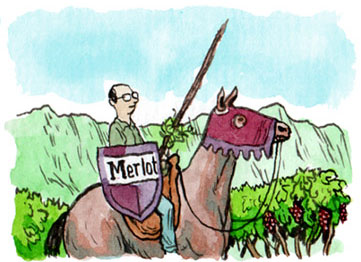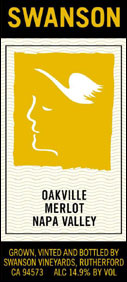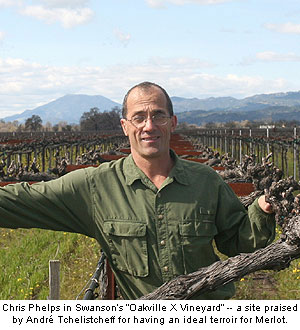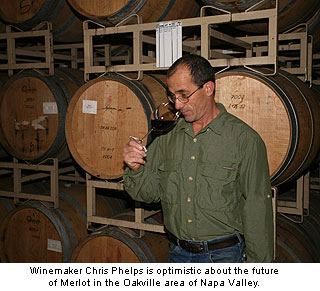

Swanson Vineyards' Chris Phelps defends Merlot in the Napa Valley.
Chris Phelps defends Merlot's place in the high end Napa Valley wine market
"From a winemaking point of view, the acidity (from Merlot grapes in Oakville) is remarkably balanced."
~ Chris Phelps, winemaker - Swanson Vineyards
by
Alan Goldfarb
August 28, 2006
Alan Goldfarb (AG): Swanson Vineyards is located in Rutherford, yet you use fruit from Oakville. Why?

Chris Phelps (CP): We have no vineyards at the winery. We own 130 acres in Oakville. Eighty are planted on the Oakville Crossroad between Opus One and Silver Oak, which is the heart of our Merlot program. We call the vineyard Oakville Cross. (Swanson also owns the Schmidt Ranch behind Brix restaurant on Highway 29, which is the heart of its Cabernet-based Alexis wine.)
AG: Why produce Merlot from Oakville? Is it generally accepted that the variety needs a cooler climate – such as Oak Knoll and Los Carneros – to thrive?
CP: It can be pretty cool in Carneros in September and October. It’ll be 75 during the day and get down to 50 at night. When I was buying fruit there for Caymus, it was a test of patience to get grapes ripe. In Oakville, the days are in the 90s and we still go down to the 50s (at night). Cold nights lock in aromas and acidity. Most growers will tell you that Merlot is susceptible to shatter (brought about by frost, rain and mold, or early heat waves in the spring) and shot berry (undeveloped small, seedless berries.) But in Oakville we have very, very little problem. We drop a lot of crop every year.
Even in Oak Knoll, Stags Leap, and Carneros, Merlot is sometimes decimated by inclement or even less-than-ideal spring weather.Yet we have a very regular crop in Oakville for Merlot. There must be something about the Merlot terroir in Oakville that is very welcoming. Even frost-wise, we don’t struggle. Carneros producers seem to get hit very hard with wind and temperature. Here the warm spring might help with flowering and fruit set; and, so we have nice, beautiful clusters every year.
From a winemaking point of view, the acidity (from Merlot grapes in Oakville) is remarkably balanced. We’re not adding acidity. It just comes in with these great numbers. There’s little variation - 3.6-3.7 pH load after load - which I think is the right balance, so that also speaks of a terroir that is Merlot friendly.
Some Oakville Cabs can be very high in pH. I know a lot of people add acid and in turn, that makes the tannins hard. But Merlot is a winemaker’s dream.
AG: With Swanson’s philosophy to keep making Merlot – you even held a seminar on the variety – aren’t you pushing uphill because of the public’s perception that the grape isn’t worth spending their money on?
CP: It’s our mantra. André Tchelistcheff (the departed patriarch of California wine) was a longtime consultant. He said “this (the Oakville X Vineyard) would be a great Merlot vineyard, don’t plant Cabernet here.”
AG: What about those soils?
CP: There’s a lot of clay, which is appropriate for Merlot, but generally not good for Cabernet. Merlot is not a drought-tolerant variety as a rule and clay has this unique aspect that essentially acts as a reservoir to hold water under the right conditions. If it becomes saturated, it doesn’t hold water for very long. Even though we’re close to the Napa River, we have this unique terroir. There are also some sand and cobbles, which is good because you have to have a certain amount of drainage.
We could sell that vineyard, but the Swansons are committed to it. We started to replant with modern clones, spacing, and trellising. The Swansons take it very personally. If you’re going to be in the Merlot business, this is the right place for it.
AG: Was it always like that at Swanson?
CP: Swanson has changed horses in midstream. They made too many Chardonnays. Management, and I include myself, need to have a three-pronged approach by excelling at three wines. For Swanson, that is Merlot, the Cab-based Alexis, and Pinot Grigio.
AG: Why don’t you think Merlot is going the way of Chardonnay?
CP: There is an ocean of Merlot out there, but we can help you separate the wheat from the chaff.
AG: How are you going to do that?
CP: By promoting the idea that you need to look at appellation. You need to define what appellations Merlot comes from -- Oakville, Howell Mountain, Carneros. The next step is to get wineries to grow their own grapes and control their own destiny.
And be prepared to spend $30 or more. (Swanson’s Merlot sells for $34 retail, with increases to $40 built in and coming soon).
AG: How difficult a task are you facing?
CP: A year ago I would have been a little more discouraged. But now we’re buoyed by what we’ve seen at our seminars, “Merlot Fights Back” (The tour visited cities such as San Francisco, San Diego, Las Vegas, Chicago, New York, Miami, and Orlando). We received some great feedback.
The quirkiness of the marketplace doesn’t call for Merlot because it’s not ‘cool’ right now. What's great is that the “Sideways” thing has almost blown over. People have settled back down. There’s been a resurgence of Merlot, which is showing in our sales. There’s momentum.
As a category Merlot may continue to slip. The plonk isn’t as easy to sell anymore. Some people have gotten out of the Merlot business who shouldn’t have been there in the first place. Merlot is still hanging in there behind Chardonnay. But it is that upper tier that we’re most focused on.
AG: And it is that upper tier that will eventually determine whether Chris Phelps’ mission is successful. If he can infuse them with his own passion for Merlot, while educating them to look for quality Merlots, then the category will flourish. Phelps’ seminar is a good first step in that direction. And perhaps one day, he’ll be conducting a seminar on the history of how “Merlot Came Back.”
On a personal note concerning Chris Phelps: He is a Boy Scout leader and was among the group of Troop One based in St. Helena, that saw two of its members die after getting struck by lightning in the Sierra last July. Phelps himself was hit and injured, along with Scoutmaster Stu Smith, the co-owner of Smith-Madrone Winery. Ryan Collins, the grandson of grower Bill Collins, who founded Conn Creek Winery, was killed; as wa

Chris Phelps (CP): We have no vineyards at the winery. We own 130 acres in Oakville. Eighty are planted on the Oakville Crossroad between Opus One and Silver Oak, which is the heart of our Merlot program. We call the vineyard Oakville Cross. (Swanson also owns the Schmidt Ranch behind Brix restaurant on Highway 29, which is the heart of its Cabernet-based Alexis wine.)
AG: Why produce Merlot from Oakville? Is it generally accepted that the variety needs a cooler climate – such as Oak Knoll and Los Carneros – to thrive?
CP: It can be pretty cool in Carneros in September and October. It’ll be 75 during the day and get down to 50 at night. When I was buying fruit there for Caymus, it was a test of patience to get grapes ripe. In Oakville, the days are in the 90s and we still go down to the 50s (at night). Cold nights lock in aromas and acidity. Most growers will tell you that Merlot is susceptible to shatter (brought about by frost, rain and mold, or early heat waves in the spring) and shot berry (undeveloped small, seedless berries.) But in Oakville we have very, very little problem. We drop a lot of crop every year.
Even in Oak Knoll, Stags Leap, and Carneros, Merlot is sometimes decimated by inclement or even less-than-ideal spring weather.Yet we have a very regular crop in Oakville for Merlot. There must be something about the Merlot terroir in Oakville that is very welcoming. Even frost-wise, we don’t struggle. Carneros producers seem to get hit very hard with wind and temperature. Here the warm spring might help with flowering and fruit set; and, so we have nice, beautiful clusters every year.
From a winemaking point of view, the acidity (from Merlot grapes in Oakville) is remarkably balanced. We’re not adding acidity. It just comes in with these great numbers. There’s little variation - 3.6-3.7 pH load after load - which I think is the right balance, so that also speaks of a terroir that is Merlot friendly.
Some Oakville Cabs can be very high in pH. I know a lot of people add acid and in turn, that makes the tannins hard. But Merlot is a winemaker’s dream.
AG: With Swanson’s philosophy to keep making Merlot – you even held a seminar on the variety – aren’t you pushing uphill because of the public’s perception that the grape isn’t worth spending their money on?

CP: It’s our mantra. André Tchelistcheff (the departed patriarch of California wine) was a longtime consultant. He said “this (the Oakville X Vineyard) would be a great Merlot vineyard, don’t plant Cabernet here.”
AG: What about those soils?
CP: There’s a lot of clay, which is appropriate for Merlot, but generally not good for Cabernet. Merlot is not a drought-tolerant variety as a rule and clay has this unique aspect that essentially acts as a reservoir to hold water under the right conditions. If it becomes saturated, it doesn’t hold water for very long. Even though we’re close to the Napa River, we have this unique terroir. There are also some sand and cobbles, which is good because you have to have a certain amount of drainage.
We could sell that vineyard, but the Swansons are committed to it. We started to replant with modern clones, spacing, and trellising. The Swansons take it very personally. If you’re going to be in the Merlot business, this is the right place for it.
AG: Was it always like that at Swanson?
CP: Swanson has changed horses in midstream. They made too many Chardonnays. Management, and I include myself, need to have a three-pronged approach by excelling at three wines. For Swanson, that is Merlot, the Cab-based Alexis, and Pinot Grigio.
AG: Why don’t you think Merlot is going the way of Chardonnay?
CP: There is an ocean of Merlot out there, but we can help you separate the wheat from the chaff.
AG: How are you going to do that?
CP: By promoting the idea that you need to look at appellation. You need to define what appellations Merlot comes from -- Oakville, Howell Mountain, Carneros. The next step is to get wineries to grow their own grapes and control their own destiny.
And be prepared to spend $30 or more. (Swanson’s Merlot sells for $34 retail, with increases to $40 built in and coming soon).

AG: How difficult a task are you facing?
CP: A year ago I would have been a little more discouraged. But now we’re buoyed by what we’ve seen at our seminars, “Merlot Fights Back” (The tour visited cities such as San Francisco, San Diego, Las Vegas, Chicago, New York, Miami, and Orlando). We received some great feedback.
The quirkiness of the marketplace doesn’t call for Merlot because it’s not ‘cool’ right now. What's great is that the “Sideways” thing has almost blown over. People have settled back down. There’s been a resurgence of Merlot, which is showing in our sales. There’s momentum.
As a category Merlot may continue to slip. The plonk isn’t as easy to sell anymore. Some people have gotten out of the Merlot business who shouldn’t have been there in the first place. Merlot is still hanging in there behind Chardonnay. But it is that upper tier that we’re most focused on.
AG: And it is that upper tier that will eventually determine whether Chris Phelps’ mission is successful. If he can infuse them with his own passion for Merlot, while educating them to look for quality Merlots, then the category will flourish. Phelps’ seminar is a good first step in that direction. And perhaps one day, he’ll be conducting a seminar on the history of how “Merlot Came Back.”
On a personal note concerning Chris Phelps: He is a Boy Scout leader and was among the group of Troop One based in St. Helena, that saw two of its members die after getting struck by lightning in the Sierra last July. Phelps himself was hit and injured, along with Scoutmaster Stu Smith, the co-owner of Smith-Madrone Winery. Ryan Collins, the grandson of grower Bill Collins, who founded Conn Creek Winery, was killed; as wa













